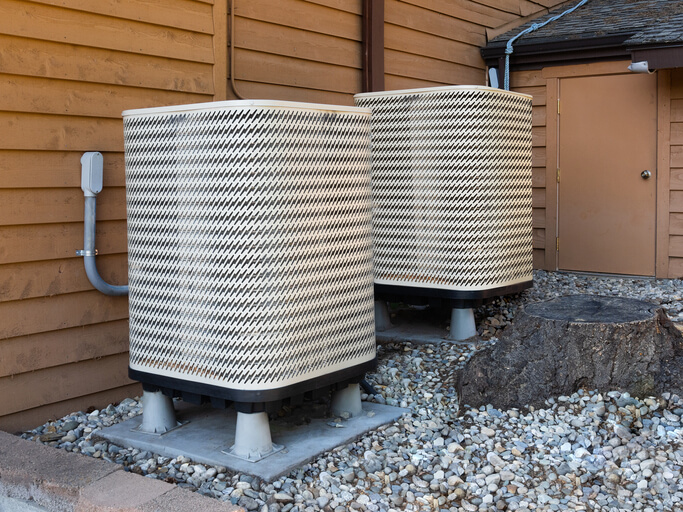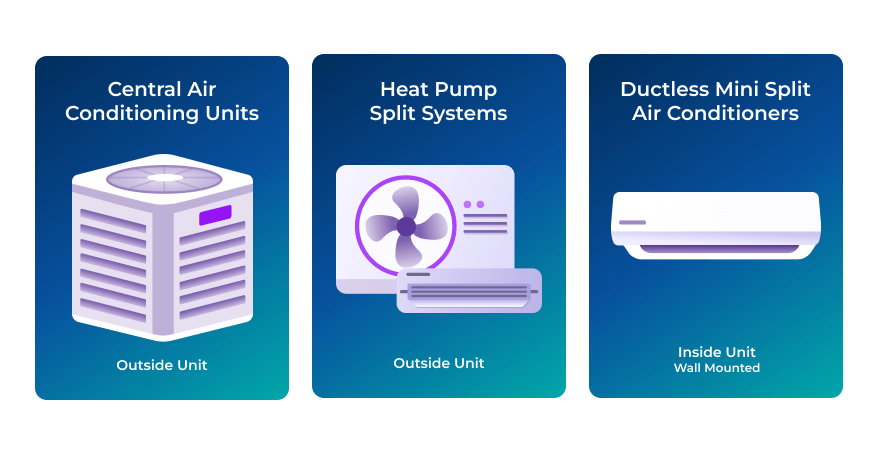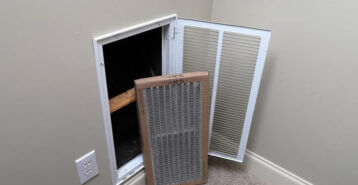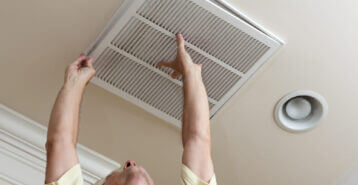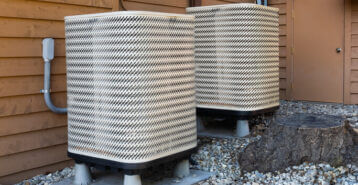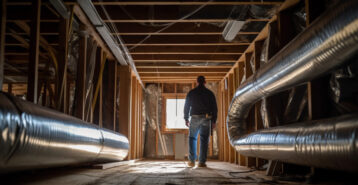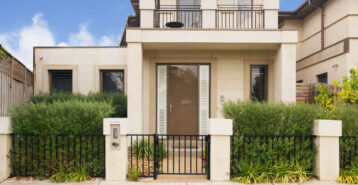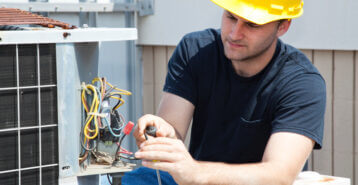Complete Guide to Installing a Central AC Unit
Your home’s central AC unit is a critical component when it comes to cooling your home and being comfortable. Understanding how a new central air conditioner works, what to expect with the installation process, factors that may affect your purchase, and how to hire a qualified contractor are all essential to getting the best return on your home investment.
How Does a Central AC Unit Work?
A central air conditioning (AC) unit installation connects a new AC unit to a home’s duct system to cool your home. It is often paired with a heating system such as a furnace to fully regulate your home’s cooling and heating efforts for the perfect temperature across the entire home.
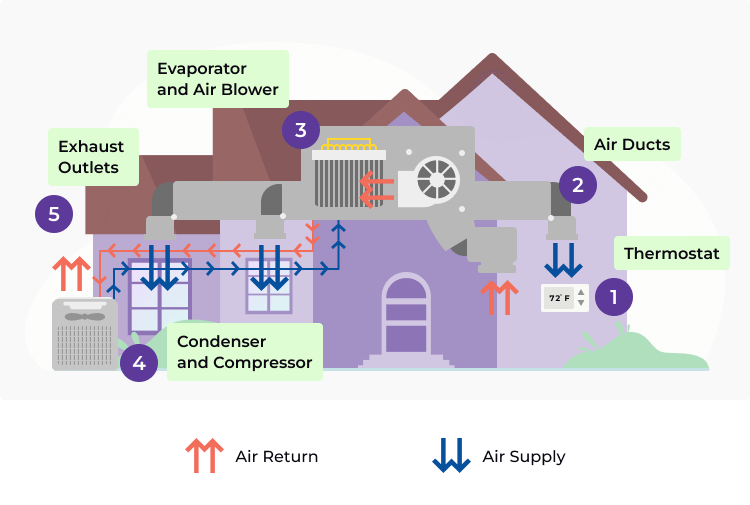
Which Homes Are Best For a Central AC Unit?
When deciding if a central AC unit is the right choice for your home, several factors come into play. The age of your home, the size and layout of your home, and your region’s climate zone influence the best cooling option for your home. Here’s a breakdown of these factors to help guide your decision.
Home Age
Most homes built after the late 1960s come with the necessary infrastructure for central cooling. However, older homes without ductwork or proper piping will face added time, complexity, and costs for installation.
Size and Layout
Larger homes and two-story homes where heat rises are good candidates for central air conditioning. Use our air conditioner size calculator to determine the right size for your home.
A smaller home with an open-plan style layout may already enjoy adequate cooling from cross-ventilation. Another type of central air or cooling system may be a better and more cost-effective option.
Region
Some cooling systems are more prevalent in different climates. For example, homes in areas with milder summers may be able to stay cool with an attic fan, AC heat pump, or another cooling system. In desert areas, evaporative coolers are a popular and energy-efficient option. Your HVAC contractor can help you select the best cooling solution for your home and household.
When To Plan for a Central AC Unit Installation
Your Space Is Not Adequately Cooled
The cooling capability of air conditioners is often affected by dust accumulation in the air condenser, filters, and coils. All these parts can be cleaned easily without any outside help. If your home still isn’t cool enough after cleaning, contact an HVAC contractor to check any equipment failures and to determine if you simply need repairs or a full replacement.
Mechanical Problem With the Unit
There can be several reasons why your central AC unit is not working. These can be mechanical or technical issues with the unit that only a seasoned HVAC contractor can help with.
Time of Year
When Your Budget Allows
A home air conditioner replacement is not the most expensive home improvement project, but the cost can be significant, especially if it is unplanned. The average cost to replace an AC unit ranges from $6,465 to $11,877. Use the Modernize cost calculator for more detailed pricing estimates for your needs.
What Happens During AC Installation?
It takes between four and eight hours to replace an AC unit. If you are installing central air conditioning for the first time, plan on an additional two to four days for ductwork installation. Here are the steps for a central air conditioning replacement:
- Removal and disposal of the existing AC unit.
- Inspection of ductwork, electrical connections, and piping to determine if anything needs to be repaired or replaced.
- Installation of new AC unit and addition of refrigerant.
- Addition of refrigerant.
- Testing and inspection to ensure the new unit works properly.
- Installation of a new thermostat if needed.
- Final inspection.
Hiring an HVAC Contractor
Hiring a reliable local HVAC installer is crucial for your project. A high level of training, knowledge, and experience is required for proper installation of central air conditioners. The system’s main components—the evaporator and the condenser—are sealed units. Special training and tools are needed for servicing them.
Choosing the right central air conditioning contractor is as important as selecting the best HVAC system. Before hiring, verify that the contractor is licensed and insured for the work. They should also be authorized to replace refrigerant, as required by the Environmental Protection Agency. It is advisable to select a professional accredited by the Air Conditioning Contractors of America (ACCA), as they are trained in current methods and ANSI standards. If desired, HVAC pros can be found through Modernize. All contractors are vetted for you.
The Better Business Bureau (BBB) is a valuable resource for vetting contractors. Any complaints, lawsuits, or concerns will be on file regarding the HVAC contractor. Online reviews can also help determine if your central AC contractor is a good choice.
For more information, click on our full checklist for hiring an HVAC contractor and find questions to ask before making your decision.
How To Prepare for Your Central AC Unit Installation
Preparing for the installation of your central AC unit is essential to ensure a smooth and efficient process. Here are five key steps to help you get ready:
- Assess Your Home’s Needs: Determine the appropriate size and type of AC unit for your space.
- Clear the Installation Area: Remove any furniture or obstructions near the installation site to give contractors easy access.
- Check Ductwork and Electrical Systems: Inspect existing ductwork for damage and ensure your electrical system can support the new unit.
- Schedule Installation During Off-Peak Times: Plan for installation in spring or fall when HVAC professionals have more availability.
- Discuss Preferences with Your Contractor: Communicate any specific concerns or preferences about the installation process.
Central HVAC Maintenance
The benefits of preventive central air conditioner maintenance checkups on your HVAC system far outweigh the costs of repair service. With regular preventive maintenance checkups, you can expect:
- Peak performance from your central air conditioning system when you need it most (No one wants their system to malfunction in August).
- Increased energy efficiency, as a finely tuned and maintained unit will consume less energy, reducing your energy costs.
- Early warning of potential equipment failures in the future.
- Peace of mind knowing your home’s central air conditioning system is in A1 condition and using energy efficiently to save on monthly energy bills.
- You will also want to have your AC coils cleaned regularly, which can be done on your own.
Good maintenance habits can lead to long-term air conditioning savings for your home, as ensuring your system is properly functioning year-round can significantly reduce energy and utility bills.
Other Types of Central Air
Split Air Conditioning Systems: Split AC or a ductless AC system has a dual central system that combines both an outside and inside AC unit to keep a comfortable temperature in your home. It has two types, a mini-split AC with a single inside unit and a multi-split AC with multiple inside units catering to multiple zones in a home.
Heat Pump Split AC Units: Split system AC units work by pumping heat out from the inside of your home to the outdoors. In cold climates, it will pump hot air into your home from outside to regulate temperature. Heat pump installations are cheaper but are best for areas without extremely cold winter climates.
AC Window Units: These are the most simple central air systems and can be installed in a regular window to cool a small area of a home.
Portable Air Conditioners: These air conditioning units are an evaporative HVAC system that can be moved around your home utilizing a split or hose system to make temperatures more comfortable.
Evaporative Coolers: An evaporative cooler warms exterior air in the home by passing it through water-soaked pads. The water quickly evaporates into the air and lowers its temperature.
Whole House Fans: Whole house fans work by drawing in cool air from open windows and pushing warm air up into attic vents and out of the home.
Compare top-rated HVAC pros in your area.
Read real homeowner reviews, explore qualifications, and view promotions. Modernize makes it easy to browse professionals and find one that will be perfect for your project.


